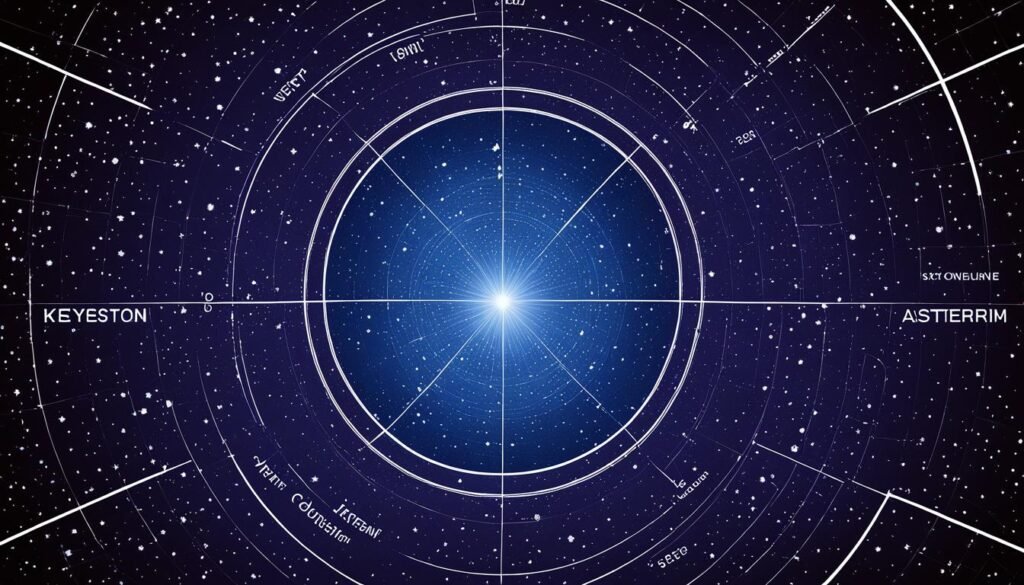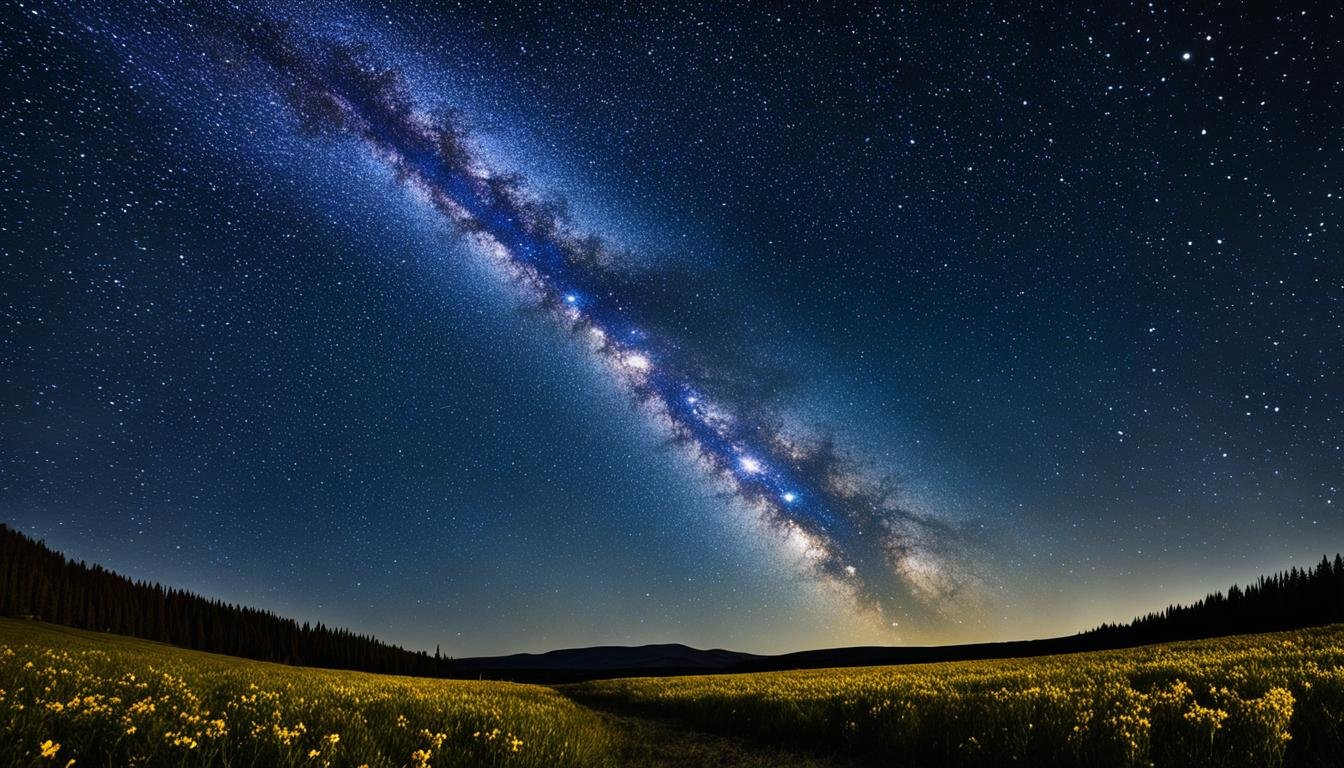If you’ve ever gazed upon the panoramic expanse of the night sky, you’re likely familiar with the various patterns that sparkle above us. Among these, the keystone asterism stands out as a notable celestial landmark. This trapezoidal configuration, encapsulated within the Hercules constellation, is not just a random assortment of stars, but a celestial guidepost that has helped steer observers towards cosmic discoveries. Comprising four bright stars—Pi, Eta, Zeta, and Epsilon Herculis—the Keystone asterism definition paints the picture of a celestial fragment that captures the essence of Hercules’ torso, anchoring itself between the bright guides of Vega and Arcturus.
Asterisms in astronomy such as the Keystone are significant not just for their beauty or ease of identification, but also for their role as navigational aids, illuminating the gateway to deeper explorations of our universe. Whether you are an avid stargazer or a casual observer, recognizing the Keystone is like unlocking a treasure trove of the night sky’s deepest mysteries.
Key Takeaways
- Understand the importance and functionality of asterisms in astronomy.
- Learn how to locate and identify the Keystone asterism among the stars.
- Discover the historical and navigational aspects of these celestial patterns.
- Find out the roles of the individual stars that construct the Keystone.
- Recognize the Keystone’s significance as a celestial guidepost for locating deep-sky objects.
Understanding Asterisms in Astronomy
As you take a journey through the night sky, you might wonder what distinguishes common patterns like the Keystone asterism from the myriad constellations overhead. Asterisms hold a unique place in the tapestry of the cosmos, functioning as celestial signposts that guide and delight skywatchers across ages and civilizations.
Defining Asterisms vs. Constellations
Quite often, asterisms in astronomy are confused with constellations. However, they are not one and the same. An asterism is a recognizable pattern of stars that can be part of an official constellation or stretch across several constellations. Unlike the 88 constellations, which are formally recognized by astronomical bodies like the International Astronomical Union, asterisms operate on a more informal basis. Despite their informal status, asterisms like the Keystone constellation play a pivotal role in stargazing and celestial navigation.
The Historical Significance of Asterisms
The patterns that you observe today, including the renown that surrounds the Keystone asterism, arose from the human fondness for storytelling and pattern recognition. Since ancient times, asterisms have been used as tools for communication and orientation, carrying tales and knowledge across generations. Their historical significance is etched not only in the night sky but also in the annals of human culture, from the mariners who relied on them for navigation to the astronomers who use them as markers for scientific discovery.
Notable Examples Beyond the Keystone
If you’ve ever gazed upon the Big Dipper, followed the line of Orion’s Belt, or admired the Great Square of Pegasus, you’ve experienced the distinct charm of asterisms. These patterns, though not officially acknowledged as constellations, are perhaps equally recognized and celebrated within the astronomical community and beyond. Each tells a unique story and serves as a navigational aid, further emphasizing the cultural and celestial importance of asterisms.
Identifying the Keystone Asterism
As you embark on celestial observations, identifying the keystone asterism is a delightful challenge that can enhance your stargazing experience. This notable pattern is found nestled in the night sky, serving as an iconic marker for amateur and experienced astronomers alike. To locate the keystone asterism, you need to scan the sky between two of the brightest stars in the northern celestial hemisphere, Vega and Arcturus.
- Begin your quest by finding Vega, the jewel of the Lyra constellation.
- Shift your gaze to identify Arcturus, the radiant star in Boötes.
- Imagine a line connecting these two stars and find a trapezoidal figure approximately a third of the way from Vega towards Arcturus.
- This distinct figure is your key to locating the keystone asterism.
The keystone serves not just as a celestial landmark but also as a portal to the larger Hercules constellation. Recognizing this pattern is like uncovering a treasure map, guiding you to further cosmic wonders scattered across the tapestry of the night sky. The keystone asterism’s role as a celestial landmark is undeniable, proving indispensable for those on a voyage of star discovery.
Below is a reference to assist you in your journey to identifying this celestial guidepost:
| Step | Direction | Description |
|---|---|---|
| 1 | North-East Sky | Locate the bright star Vega in Lyra constellation. |
| 2 | Following the Arc to Arcturus | From Vega, trace an arc to the bright star Arcturus. |
| 3 | Interstellar Pathway | Search along the imaginary line for the Keystone’s trapezoidal pattern. |
| 4 | Hercules Constellation | The keystone is a central figure in the Hercules constellation. |
With these directions, you’re well on your way to mastering the night sky and enriching your understanding of the constellations. Let the keystone asterism be a steadfast companion in your nocturnal quests, providing both orientation and inspiration as you explore the universe’s grandeur.
Stars that Compose the Keystone Asterism
The resplendent Keystone asterism is defined by four main stars, each possessing unique astral identities and contributing to the asterism’s iconic shape. As you gaze upon the night sky, the following stars of the Keystone are your guideposts to celestial discovery.

Zeta Herculis: A Multiple Star System
As the most luminous star in the Keystone asterism, Zeta Herculis illuminates the sky with aplomb. This system of stars is remarkable not only for its brightness but also for its status as a multiple star system, providing a captivating subject of study for astronomers.
Pi Herculis and Its Stellar Characteristics
Pi Herculis exudes a distinct orange glow and stands as the second most radiant star of the asterism. This bright giant of a star is situated hundreds of light-years away, yet its grandeur reaches across space to dazzle stargazers.
Insights into Eta and Epsilon Herculis
The contributions of Eta and Epsilon Herculis to this celestial structure cannot be understated. They may shine less brightly than their companions, yet their combined presence gives shape and depth to the Keystone asterism, enriching the nighttime spectacle.
| Star Name | Spectral Type | Apparent Magnitude | Distance (Light-Years) | Remarks |
|---|---|---|---|---|
| Zeta Herculis | Multiple Star System | 2.81 | 35 | Brightest star in keystone configuration |
| Pi Herculis | K3 II | Variable | 377 | Orange-hued bright giant |
| Eta Herculis | G8 III | 3.5 | 112 | Class G giant star |
| Epsilon Herculis | Spectroscopic Binary | 3.91 | 155 | Binary system enhancing asterism’s structure |
Locating the Keystone Asterism
As you gaze up at the night sky, the art of celestial navigation beckons with the distinct shape of the Keystone Asterism. Acting as a reliable guide through the celestial sphere, the Keystone’s four-star configuration is not only a marker on the Herculean constellation, but also a gateway to deeper cosmic discovery.
Positional Relationship with Bright Northern Stars
To embark on the journey of locating the keystone asterism, turn your sights toward the northern celestial hemisphere. Here, among the panorama of shimmering lights, two prominent stars stand out as beacons, leading you to the celestial landmark that is the Keystone.
Using Vega and Arcturus as Guides
Vega, the alpha star of Lyra, shines with a brilliant blue hue, while the red giant Arcturus beckons from the constellation of Boötes. To find the keystone, commence your search from Vega, gliding approximately one-third the distance toward Arcturus. It’s here, poised in the cosmos, that the Keystone makes its grand appearance.
The Ideal Conditions for Viewing
For optimal viewing of this celestial feature, seek out the darkest skies, away from the intrusive glow of city lights. Under such conditions, the Keystone stands out in sharp relief against the backdrop of the night, becoming an integral part of your celestial navigation with the keystone asterism.
Below is a visual guide to aid in conceptualizing the relative positions of Vega, Arcturus, and the Keystone Asterism:
| Star / Asterism | Constellation | Color | Relative Position |
|---|---|---|---|
| Vega | Lyra | Blue | Starting Point |
| Arcturus | Boötes | Red | Reference Point |
| Keystone Asterism | Hercules | Mixed | One-third the distance from Vega to Arcturus |

Mastering the art of locating the Keystone Asterism enriches the stargazing experience, allowing you to traverse the night sky with a seasoned astronomer’s precision. Whether it’s for sheer enjoyment or the intrinsic value of celestial navigation, the Keystone forever serves as your guide among the stars.
The Cultural and Mythological Impact of the Keystone
When you gaze up at the night sky and spot the keystone asterism, you’re not just seeing a collection of stars—you’re witnessing a legacy etched into our cosmos. The significance of the keystone asterism extends beyond the boundaries of astronomy, intertwining with tales of mythology and periods of human history marked by celestial navigation.
Stories and Mythology Linked to Hercules
For millennia, the figure of Hercules has captivated storytellers and listeners alike. The keystone asterism is reputed to outline the torso of this mythological demigod, symbolizing his strength and presence in the heavens. Hercules’ adventures have been immortalized not just through words but also by stars, making the sky a canvas for humanity’s most beloved legends.
The Keystone’s Role in Celestial Navigation
Sailors of the ancient seas relied heavily on the stars to chart their course, and the keystone asterism played a pivotal role in their journeys. Acting as a steadfast guide, it serves to this day as an essential tool for those who seek to unravel the mysteries of celestial navigation. Its importance is evident, as it continues to help educate and orient those looking up with curiosity.
| Mythological Aspect | Navigational Importance |
|---|---|
| Represents Hercules’ torso, linking stars to heroism | Crucial for locating the Hercules constellation |
| Echoes tales of valor and ancient quests | Has historically guided seafarers by night |
| Influences cultural lore and artistic representations | Facilitates modern stargazing and astronomy education |
As you explore the depths of the sky, remember the importance of the keystone asterism—a bridge between our past and the stars, between myth and the tools that bring order to the chaos of night’s vast ocean. Its story continues to unfold above us, written in light on the celestial dome.
Deep Sky Objects Near the Keystone Asterism
As you gaze upwards, the Keystone asterism not only delights with its stark outline but also directs you to a treasure trove of celestial phenomena. Nestled within this celestial landmark are a multitude of deep sky objects that offer a window into the universe’s sublime architecture. Whether you’re an amateur skywatcher or a seasoned astronomer, these mesmerizing sights invite you to probe deeper into the night sky’s mysteries.
The Splendor of the Hercules Globular Cluster (M13)
Behold the Hercules Globular Cluster, or M13, a shimmering collection of stars that may well be the crown jewel amongst the deep sky objects accessible through the Keystone. Located near Eta Herculis, this tightly bound spherical ensemble of stars is a captivating sight for your telescope. On a clear night, M13’s densely packed stellar community is a testament to the intricacies of cosmic forces at play.
Exploring NGC 6207 and Other Galaxies
Beyond the luster of stellar clusters, the sky’s expanse near the Keystone harbors galaxies such as NGC 6207. This spiral galaxy, a faint whisper of light against the cosmic backdrop, lies in proximity, offering a sublime glance into a galaxy’s spiral arms. Observations of such galaxies enrich our comprehension of the cosmos’s scale and the diversity of structures that abound within it.
Globular and Planetary Nebulae around the Keystone
Further enriching the celestial array are various globular clusters and planetary nebulae that include NGC 6229 and NGC 6058. These deep sky objects, each with their own unique allure, contribute to the vast stellar anthology that the Keystone asterism so gracefully unveils. As you explore these wonders, you gain not merely a night of stargazing but an enlightened appreciation for the universe’s boundless magnificence.
FAQ
What is the Keystone Asterism?
The Keystone asterism is a notable asterism in astronomy that constitutes four bright stars—Pi, Eta, Zeta, and Epsilon Herculis—which form a trapezoidal pattern resembling a keystone. This pattern serves as a celestial guidepost within the constellation Hercules, aiding in the identification of various deep sky objects and facilitating celestial navigation.
How does an asterism differ from a constellation?
Asterisms are recognizable patterns of stars that are not officially recognized as constellations by astronomical bodies. They can be part of a single constellation or consist of stars from multiple constellations, forming a shape that stands out due to its brightness and pattern. Constellations, on the other hand, are formally acknowledged groups of stars that encompass larger areas of the night sky and often have mythological significance.
Can you highlight the historical importance of asterisms?
Asterisms have played a critical role throughout history in cultures around the world, serving as tools for navigation, calendrical markers, and as part of folklore and mythology. Their easily recognizable patterns acted as celestial waypoints for ancient sailors and travelers and continue to captivate stargazers today.
What are some other well-known asterisms?
Apart from the Keystone, other famous asterisms include the Big Dipper (in Ursa Major), Orion’s Belt (in Orion), and the Great Square of Pegasus. These asterisms are distinctive patterns of stars that have served as sky markers for various civilizations throughout history.
How can I locate the Keystone Asterism in the night sky?
To find the Keystone asterism, you should identify the bright stars Vega in the Lyra constellation and Arcturus in Boötes. The Keystone lies roughly a third of the way from Vega towards Arcturus and forms the distinctive trapezoidal shape that is associated with the Hercules constellation.
What are the main stars that compose the Keystone Asterism?
The main stars that compose the Keystone Asterism are Zeta Herculis, an illuminating multiple star system 35 light-years away; Pi Herculis, an orange giant roughly 377 light-years from Earth; and Eta Herculis and Epsilon Herculis, both contributing to the asterism’s trapezoidal shape with their own unique astronomical characteristics.
How do Vega and Arcturus assist in identifying the Keystone Asterism?
Vega and Arcturus are two bright northern stars that act as reference points for stargazers looking to find the Keystone asterism. By positioning oneself so that these two stars are in the field of view, one can scan the area a third of the distance from Vega towards Arcturus to spot the Keystone.
What is the best time and condition to view the Keystone Asterism?
The Keystone asterism is best viewed under clear skies, away from light pollution. The ideal viewing period is during late spring through summer in the Northern Hemisphere, when the constellation Hercules is well positioned in the evening sky.
What is the cultural significance of the Keystone Asterism?
The Keystone Asterism holds significant mythological importance as it represents the torso of Hercules, a hero famed in Roman and Greek lore for his strength and twelve labors. It serves as a celestial symbol of the narratives that have been told about Hercules for generations, illustrating the richness of human storytelling interwoven with the patterns observed in the night sky.
What deep sky objects are located near the Keystone Asterism?
There are several deep sky objects easily accessible from the Keystone Asterism, such as the Hercules Globular Cluster (M13), one of the brightest globular clusters visible from Earth, located near the star Eta Herculis. Other galaxies like NGC 6207 and NGC 6239, along with globular clusters like NGC 6229 and the planetary nebula NGC 6058, also lie close to the Keystone, presenting a variety of celestial phenomena for observation and study.






